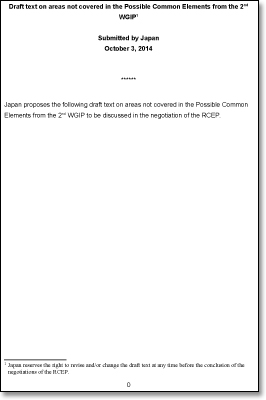|
Japan’s Submission of IP (Intellectual Property) in the RCEP "Protecting the Intellectual Property and Privatization Interests of Big Ag Biotech companies Like Monsanto, Cargill and Nestlé ..." by Arnie Saiki Los Angeles, California
The RCEP will likely conclude in 2015, and this partnership includes the 10-nation ASEAN, plus six others: China, India, Japan, South Korea, Australia and New Zealand. The combined economic output of the bloc reached $21.3 trillion in 2013, which accounts for nearly 30 per cent of the world output. Additionally, at the most recent APEC meeting in Beijing in November, the RCEP seems to have evolved into a larger more comprehensive Free-Trade Area of the Asia Pacific (FTAAP). The document embedded in this page is from October 2014. It is Japan’s submission of a draft text on areas not covered in the RCEP’s Intellectual Property (IP) elements, and the importance of this document should be read against the secrecy of the TPP, the upcoming Sustainable Development Goals (SDGs), and the RCEP, which if we were to take the title of Japan’s submission literally, does not contain these provisions. Under the Enforcement Civil Remedies Article, “Destroying Infringing Goods and Materials and Implements,” Japan would like to see each party adopt procedures by which its policing authorities upon infringement of plant breeder’s rights for new varieties of plants will have the authority to destroy goods and dispose of them outside the channels of commerce in such a manner as to avoid any harm to the right holder. As far as the SDGs go, protecting the Intellectual Property and privatization interests of Big Ag (agriculture) biotech companies like Monsanto, Cargill, and Nestlé is the poor option for feeding the world. And now, as we prepare to write the rules of the Sustainable Development Goals, one would think that the dispute between local farming and Big Ag would be a moot point, as I think we pretty much know by now that Big Ag will steal and starve the world if it could continue to turn a profit. Between Nestlé’s privatization agenda of global water supplies, Monsanto’s 150 lawsuits (with another 700+ being settled out of court) against family farmers, and Cargill’s land grabs, small developing countries would hardly be able to afford the corporate bullying of these large transnational corporations. If it seems that the SDGs are a different issue from trade partnerships like the TPP and the RCEP, it is. But when one considers that the fight over rules for trade and investment in the 21st century is being waged between these trade partnerships, one has to realize that how trade and investments occur within the 17 sectors of the SDGs will be determined by these rules. The good news is that we have not seen this kind of provisions in the China-led RCEP. The fact that Japan is submitting it, suggests that it was not there to begin with. The bad news is that these are the kind of provisions that are likely contained within the TPP/TTIP, and if it should conclude Big Ag and biotech like Monsanto, Cargill and Nestle will a have global venue for displacing local farmers and stealing their land and crops as they have done in Mexico and the U.S. under the North American Free Trade Agreement, and the Central American Countries under CAFTA (Central America Free Trade Agreement). Because of India’s size and population, if Prime Minister Modi does indeed join with the TPP, India’s membership will have the potential of tipping the rules of trade and investment in favor of the TPP, which will in turn likely impact how the SDGs will be concluded. This includes the process through which the developing world will access medicines and control its plants and plant properties. To conclude, the collapse of the Wall St. investment banks in 2008 needs to be seen as a failure of the neoliberal system. The BRICS (Brazil, Russia, India, China, South Africa) emerging economies were only mildly impacted. And, as a result of the neoliberal failure, the BRICS alignment formally announced their partnership with the Fortaleza Declaration this past summer in Brazil on the sidelines of the World Cup. This formal agreement brought about the emergence of the New Development Bank (NDB), the Asian Infrastructure Investment Bank (AIIB), and the Contingency Reserve Arrangement (CRA) -- new global institutions that seek an alternative development and financial arrangement to the Organization or Economic Cooperation and Development (OECD), the World Bank, the Asian Development Bank (ADB) and the International Monetary Fund (IMF), respectively. Since the creation of these new alternative global institutions, the U.S. has been struggling to reassert the Wall St. neoliberal process, however, both international investment and the developing countries have been nurturing closer relations with BRICS. What this means for U.S. investment is that the debt that was leveraged off the equity and resources of developing countries is no longer as accessible as it once was under the unipolarity of the Wall St. investment regime. Arnie Saiki -- Coordinator of Moana Nui. Director of Imipono Projects. Also see:
|
||||
If you have any thoughts on this or would like to contribute to an ongoing discussion in the  What is New? || Affirmative Action || Art Changes || Autonomy: Chiapas - California || Community Images || Education Rights || E-mail, Opinions and Discussion || En español || Essays from Ireland || Global Eyes || Healthcare || Human Rights/Civil Rights || Piri Thomas || Photo of the Week || QA: Interviews || Region || Rural America || Search || Donate || To be notified of new articles || Survey || In Motion Magazine's Store || In Motion Magazine Staff || In Unity Book of Photos || Links Around The World NPC Productions Copyright © 1995-2015 NPC Productions as a compilation. All Rights Reserved. |


